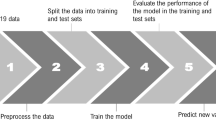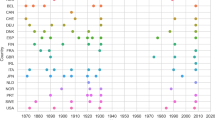Abstract
In this study, we investigate and apply the models from the machine learning (ML) paradigm to forecast the inflation rate. The models identified are ridge, lasso, elastic net, random forest, and artificial neural network. We carry out the analysis using a data set with 56 features of 132 monthly observations from January 2012 to December 2022. The random forest (RF) model can forecast the inflation rate with greater accuracy than other ML models. A comparison to benchmark econometric models like auto-regressive integrated moving average demonstrates the superior performance of the RF model. Moreover, nonlinear ML models are proven to be more successful than a linear ML or time series models and this is mostly due to the unpredictability and interactions of variables. It indicates that the significance of nonlinear structures for forecasting inflation is important. Furthermore, the ML models outweigh the benchmark econometric model in forecasting the undulations due to the COVID-19 impact. The findings in this study support the benefit of applying ML models to forecast the inflation rate. Even without considering the sporadicity of pandemic, nonlinear model like artificial neural network (ANN) outweighs other models. Additionally, the ML models like RF and ANN model yield variable importance measures for each explanatory variable. ML models shows capability to not only better forecasting but also able to provide the insight regarding the covariates for improved forecasting results and policy prescriptions.

(Source: Authors’ drawing)

Source: Author’s calculation

Similar content being viewed by others
Data availability
Data can be made available on request by the corresponding author.
References
Binner, J.M., R.K. Bissoondeeal, T. Elger, A.M. Gazely, and A.W. Mullineux. 2005. A comparison of linear forecasting models and neural networks: An application to Euro inflation and Euro Divisia. Applied Economics 37 (6): 665–680.
Blanchflower, D.G., and C. MacCoille. 2009. The formation of inflation expectations: an empirical analysis for the UK (No. w15388). National Bureau of Economic Research.
Box, G.E., G.M. Jenkins, G.C. Reinsel, and G.M. Ljung. 2015. Time series analysis: Forecasting and control. Hoboken: Wiley.
Breiman, L. 1996. Bagging predictors. Machine Learning 24: 123–140.
Breiman, L. 2001. Random forests. Machine Learning 45: 5–32.
Breiman, L., J.H. Friedman, R.A. Olshen, and C.J. Stone. 1984. Classification and regression trees. Statistics/probability series.
Brouwer, G.D., and N.R. Ericsson. 1998. Modeling inflation in Australia. Journal of Business & Economic Statistics 16 (4): 433–449.
CMIE. 2022. Dataset of all variables. Retrieved March 22, 2023 from CMIE Economic Outlook.
Das, A., K. Lahiri, and Y. Zhao. 2019. Inflation expectations in India: Learning from household tendency surveys. International Journal of Forecasting 35 (3): 980–993.
Garson, G.D. 1991. Interpreting neural-network connection weights. AI Expert 6 (4): 46–51.
Goh, A.T. 1995. Back-propagation neural networks for modeling complex systems. Artificial Intelligence in Engineering 9 (3): 143–151.
Gordon, R.J. 1975. The demand for and supply of inflation. The Journal of Law and Economics 18 (3): 807–836.
Goulet Coulombe, P., M. Leroux, D. Stevanovic, and S. Surprenant. 2022. How is machine learning useful for macroeconomic forecasting? Journal of Applied Econometrics 37 (5): 920–964.
Goyal, A., and P. Parab. 2019. Modeling heterogeneity and rationality of inflation expectations across Indian households. Indira Gandhi Institute of Development Research, Working Paper.
Hall, R.E., and T.J. Sargent. 2018. Short-run and long-run effects of Milton Friedman’s presidential address. Journal of Economic Perspectives 32 (1): 121–134.
Hoerl, A.E., and R.W. Kennard. 1970. Ridge regression: Biased estimation for nonorthogonal problems. Technometrics 12 (1): 55–67.
Inoue, A., and L. Kilian. 2008. How useful is bagging in forecasting economic time series? A case study of US consumer price inflation. Journal of the American Statistical Association 103 (482): 511–522.
James, G., D. Witten, T. Hastie, and R. Tibshirani. 2013. An introduction to statistical learning, vol. 112, 18. New York: Springer.
Liu, L.M. 1986. Identification of time series models in the presence of calendar variation. International Journal of Forecasting 2 (3): 357–372.
Masini, R.P., M.C. Medeiros, and E.F. Mendes. 2023. Machine learning advances for time series forecasting. Journal of Economic Surveys 37 (1): 76–111.
Medeiros, M.C., G.F. Vasconcelos, Á. Veiga, and E. Zilberman. 2021. Forecasting inflation in a data-rich environment: The benefits of machine learning methods. Journal of Business & Economic Statistics 39 (1): 98–119.
Mullainathan, S., and J. Spiess. 2017. Machine learning: An applied econometric approach. Journal of Economic Perspectives 31 (2): 87–106.
Nakamura, E. 2005. Inflation forecasting using a neural network. Economics Letters 86 (3): 373–378.
Patra, M.D., and P. Ray. 2010. Inflation expectations and monetary policy in India: An empirical exploration. IMF Working Paper. https://doi.org/10.5089/9781451982640.001.
Pradhan, R.P. 2011. Forecasting inflation in India: An application of ANN model. International Journal of Asian Business and Information Management (IJABIM) 2 (2): 64–73.
Pratap, B., and S. Sengupta (2019). Macroeconomic forecasting in India: Does machine learning hold the key to better forecasts?
Raj, J., S. Dhal, and R. Jain. 2008. Imported inflation: The evidence from India. New Delhi: Reserve Bank of India.
Rani, S.J., V.V. Haragopal, and M.K. Reddy. 2017. Forecasting inflation rate of India using neural networks. International Journal of Computer Applications 158 (5): 45–48.
Sharma, N.K., and M. Bicchal. 2018. The properties of inflation expectations: Evidence for India. Economia 19 (1): 74–89.
Siami-Namini, S., N. Tavakoli, and A.S. Namin. 2019. A comparative analysis of forecasting financial time series using ARIMA, LSTM, and BILSTM. arXiv preprint arXiv:1911.09512.
Sims, C.A. 1990. Macroeconomics and reality. Econometrica: Journal of the Econometric Society 1: 1–52. https://doi.org/10.2307/1912017.
Stock, J.H., and M.W. Watson. 1999. Forecasting inflation. Journal of Monetary Economics 44 (2): 293–335.
Stock, J.H., and M.W. Watson. 2002. Macroeconomic forecasting using diffusion indexes. Journal of Business & Economic Statistics 20 (2): 147–162.
Stock, J.H., and M.W. Watson. 2007. Why has US inflation become harder to forecast? Journal of Money, Credit and Banking 39: 3–33.
Thakur, G.S.M., R. Bhattacharyya, and S.S. Mondal. 2016. Artificial neural network based model for forecasting of inflation in India. Fuzzy Information and Engineering 8 (1): 87–100.
Tibshirani, R. 1996. Regression shrinkage and selection via the lasso. Journal of the Royal Statistical Society: Series B (methodological) 58 (1): 267–288.
Zhang, G., B.E. Patuwo, and M.Y. Hu. 1998. Forecasting with artificial neural networks: The state of the art. International Journal of Forecasting 14 (1): 35–62.
Zou, H. 2006. The adaptive lasso and its oracle properties. Journal of the American Statistical Association 101 (476): 1418–1429.
Zou, H., and T. Hastie. 2005. Regularization and variable selection via the elastic net. Journal of the Royal Statistical Society: Series B (statistical Methodology) 67 (2): 301–320.
Author information
Authors and Affiliations
Corresponding author
Additional information
Publisher's Note
Springer Nature remains neutral with regard to jurisdictional claims in published maps and institutional affiliations.
Rights and permissions
Springer Nature or its licensor (e.g. a society or other partner) holds exclusive rights to this article under a publishing agreement with the author(s) or other rightsholder(s); author self-archiving of the accepted manuscript version of this article is solely governed by the terms of such publishing agreement and applicable law.
About this article
Cite this article
Das, P.K., Das, P.K. Forecasting and Analyzing Predictors of Inflation Rate: Using Machine Learning Approach. J. Quant. Econ. (2024). https://doi.org/10.1007/s40953-024-00384-z
Accepted:
Published:
DOI: https://doi.org/10.1007/s40953-024-00384-z




